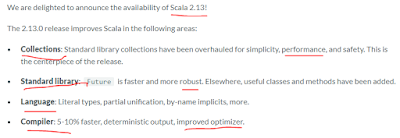What is Scala - Scala's design has been influenced by many programming languages and ideas in programming language research. Beginner Notes on SCALA.
- In fact, only a few features of Scala are genuinely new; most have been already applied in some form in other languages. Scala's innovations come primarily from how its constructs are put together.
- At the surface level, Scala adopts a large part of the syntax of Java and C#, which in turn borrowed most of their syntactic conventions from C and C++. Expressions, Statements, and blocks are mostly as in Java, as is the syntax of classes, packages, and imports.
- Besides syntax, Scala adopts other elements of Java, such as its basic types, its class libraries, and its execution model.
Scala's new version.
Scala also owes much to other languages. Its uniform object model was pioneered by Smalltalk and taken up subsequently by Ruby.
-
Its idea of universal nesting (almost every construct in Scala can be nested inside any other construct) is also present in Algol, Simula, and, more recently in Beta and g-beta.
- Its uniform access principle for method invocation and field selection comes from Eiffel.
- Its approach to functional programming is quite similar in spirit to the ML family of languages, which has SML, OCaml, and F# as prominent members. Many higher-order functions in Scala's standard library are also present in ML or Haskell.
- Scala's implicit parameters were motivated by Haskell's type classes; they achieve analogous results in a more classical object-oriented setting. Scala's actor-based concurrency library was heavily inspired by Erlang.
- Scala is not the first language to emphasize scalability and extensibility. The historic root of extensible languages that can span different application areas is Peter Landin's 1966 paper "The Next 700 Programming Languages."
- Scala is also not the first language to integrate functional and object-oriented programming, although it probably goes furthest in this direction. Other languages that have integrated some elements of functional programming into OOP include Ruby, Smalltalk, and Python.
- On the Java platform, Pizza, Nice, and Multi-Java have all extended a Java-like core with functional ideas. There are also primarily functional languages that have acquired an object system; examples are OCaml, F#, and PLT-Scheme.
- Scala has also contributed some innovations to the field of programming languages. For instance, its abstract types provide a more object-oriented alternative to generic types, its traits allow for flexible component assembly, and its extractors provide a representation-independent way to do pattern matching. These innovations have been presented in papers at programming language conferences in recent years.
Why Scala.
Scala doesn't require you to leap backward off the Java platform to step forward from the Java language. It allows you to add value to existing code—to build on what you already have—because it was designed for seamless interoperability with Java.
Scala programs compile to JVM bytecodes. Their run-time performance is usually on par with Java programs.
Scala code can call Java methods, access Java fields, inherit from Java classes, and implement Java interfaces. None of this requires special syntax, explicit interface descriptions, or glue code. In fact, almost all Scala code makes heavy use of Java libraries, often without programmers being aware of this fact.
Another aspect of full interoperability is that Scala heavily re-uses Java types. Scala's Ints are represented as Java primitive integers of type int, Floats are represented as floats, Booleans as booleans, and so on. Scala arrays are mapped to Java arrays.
Scala also re-uses many of the standard Java library types. For instance, the type of a string literal "abc" in Scala is java.lang.String, and a thrown exception must be a subclass of java.lang.Throwable.




.jpg)
Comments
Post a Comment
Thanks for your message. We will get back you.